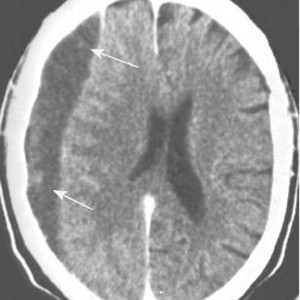The standard of care in most high level trauma centers is to involve neurosurgeons in the care of patients with significant traumatic brain injury (TBI). However, not all hospitals that take care of trauma patients have immediate availability of this resource. A paper to be presented at the upcoming EAST meeting looked at management of these patients by acute care surgeons.
The authors retrospectively reviewed all patients who had a TBI and positive head CT managed with or without neurosurgery consultation over a two year period. Although the authors were from the University of Arizona, a Level I ACS trauma center, the abstract does not explicitly state whether the patients were seen in their hospital or another lower level one.They matched the patients with and without neurosurgical consultation for age, GCS, AIS-Head and presence of skull fracture and intracranial hemorrhage.
A total of 90 patients with and 90 patients without neursurgical involvement were reviewed. Here are the interesting findings:
- Hospital admission rate was identical for both groups (87-90%)
- ICU admission was significantly higher if neurosurgeons were involved (20% vs 41%)
- Repeat head CT was ordered more than 3 times as often by neurosurgeons (20% vs 72%)
- Post-discharge head CT was ordered more often by neurosurgeons, but was not significantly higher (5% vs 12%)
Nothing is said about complications or mortality, or whether neurosurgeons were available in case things went awry.
Bottom line: This abstract raises an interesting question: can surgeons safely manage select patients with intracranial injury? The answer is probably yes, although this abstract is not complete enough to fully support the idea. The majority of patients with mild to moderate TBI with small intracranial bleeds do well despite everything we throw at them. And it appears that surgeons use fewer resources managing them than neurosurgeons do. The keys to being able to use this type of system are to identify at-risk patients who really do need a neurosurgeon early, and having a quick way to get the neurosurgeon involved (by consultation or hospital transfer). As neurosurgery involvement in acute trauma declines, this concept will become more and more pertinent.
Related posts:
Reference: The acute care surgery model: managing traumatic brain injury without an inpatient neurosurgical consultation. EAST Annual Scientific Assembly, Paper 10, January 2013.


